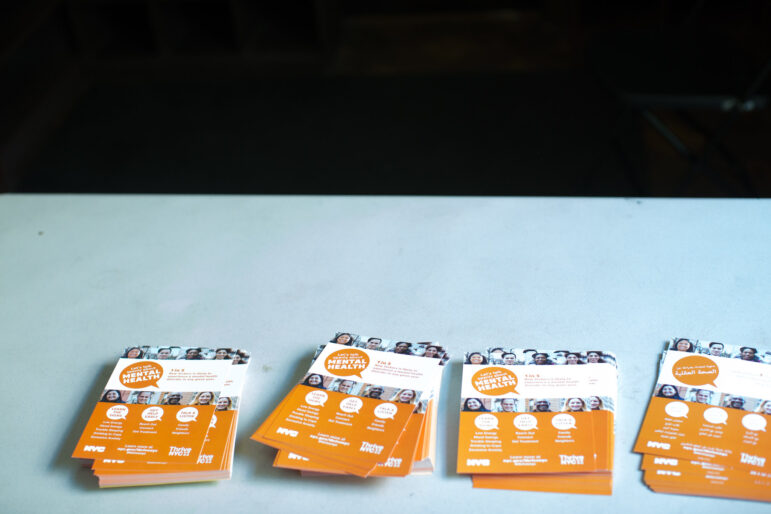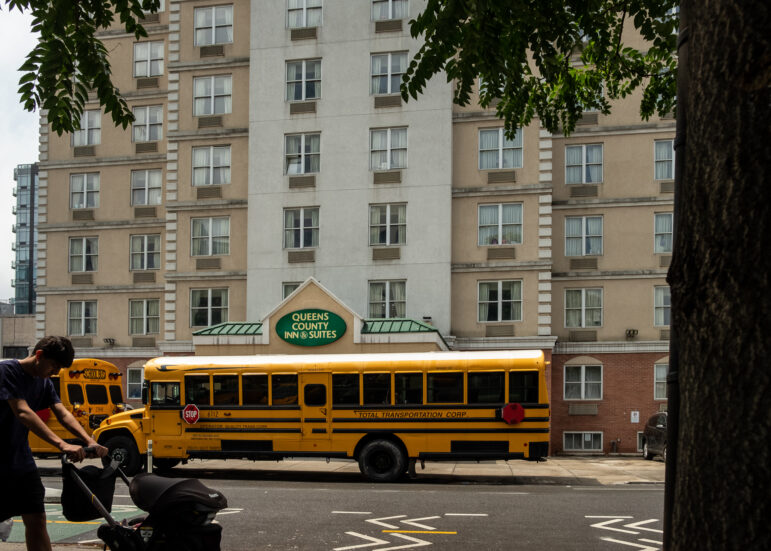“We support the plan’s vision because we see it as a chance to stand up for people just like our parents and grandparents—who struggled bravely to make a life and a future for their families.”

Empire State Development; Mike Groll/Office of Governor Kathy Hochul
Left: a map of the Creedmoor campus being eyed for new development. Right: Gov. Kathy Hochul.Lots of people are talking about the state’s plan for 2,800 housing units at the Creedmoor site. Understandably, many life-long residents of the area fear that the project would change the character of the surrounding neighborhoods. Their parents or grandparents worked hard to buy homes in Glen Oaks Village or Hollis Hills: this new plan feels like a threat to their legacy.
As two people who care deeply about the Eastern Queens community, we’ve been listening carefully to our neighbors’ concerns about the Creedmoor plan. We don’t think Gov. Kathy Hochul’s plan is perfect: there are plenty of details we want spelled out.
But we see at Creedmoor the opportunity for a new generation of New Yorkers to make a home and leave a legacy for their children and grandchildren. We support the plan’s vision because we see it as a chance to stand up for people just like our parents and grandparents—who struggled bravely to make a life and a future for their families.
It’s in that spirit that we want to address our neighbors’ concerns about the state’s plan for Creedmoor. The first big concern many neighbors have expressed is that affordable housing will bring lower-class neighbors, which in turn will bring a lower quality of life to their neighborhood.
But the families who need this affordable housing are just like us. The cost of housing has far outpaced the wages of working people. Many of us who bought in the neighborhood decades ago, or even just a few years ago when interest rates were at historic lows, wouldn’t stand a chance in today’s market. That’s why we need to build affordable housing for working families.
So far, the Creedmoor Plan has identified housing targets for households earning 80 percent of the city’s Area Median Income (AMI). A single person at 80 percent AMI earns $79,120 per year. The median income of Queens Village is about $85,000, with nearly 20 percent of residents earning less than $35,000 per year, according to the most recent census data. That means the new neighbors who would move into a Creedmoor development are earning about the same as current neighbors, in some cases maybe more.
We will certainly need to build for lower incomes as well, but that shouldn’t scare us either. For example, a two-person household at 60 percent AMI earns $67,800 per year. That’s a single-parent public school teacher looking to raise their kid in a stable and affordable home. We think teachers deserve decent housing like the rest of us.
Some of the housing in the Creedmoor plan will be set aside for seniors, like our own aging parents, and formerly homeless folks, like our most recent neighbors at Zion Church in Douglaston. These folks also need our compassion and support. Many New Yorkers don’t realize that between 30 percent and 40 percent of single people in shelters are employed and just need a helping hand to get an affordable apartment. We should all be able to empathize with folks in this situation because, as Councilmember Vickie Paladino said at a town hall about the Douglaston women’s shelter, many of us are one paycheck away from being in the same place as they are.
Our neighbors’ second big concern is about density: we’ve heard people say that building mid-rise housing will destroy the character of the area. But in Eastern Queens we already have numerous examples of six- to eight-story buildings existing side-by-side with two- and three-story garden apartments and single family homes.
Right here in Bellerose, at 245-10 Grand Central Service Road, we have 250 families living in three, seven-story apartment buildings that most residents probably don’t even realize are there. Other examples include the Windsor Park co-ops in Oakland Gardens, the Cambridge Hall buildings in Hollis Hills, and we would be remiss as members of Zion to not mention Douglaston, which has blocks of multi-family apartment buildings existing side-by-side with some of the most desirable single-family homes in the borough. Those mid-rise buildings haven’t ruined Douglaston, and they won’t ruin Glen Oaks or Queens Village.
The last concern we have heard a lot about is why we should subsidize the creation of affordable housing at all. Once again, let’s think about our parents and grandparents before pointing fingers at our new neighbors. The truth is that most housing in the United States, let alone New York City, has benefited from some subsidy. Glen Oaks Village would not exist today if the developers in 1947 had not received $54 million (nearly $750 million in 2023 dollars) in subsidized low-interest loans from the Federal Housing Administration.
Most apartment buildings have benefited from some state-backed subsidy, like 421-a, J-51, or the 1955 Mitchell-Lama program. And the largest housing subsidy over the last century has been for single-family homes. Homeownership today is built on pillars of government support, from the explicit insurance of FHA loans, to the implicit support of a massive federally-sponsored secondary mortgage market, to the mortgage interest tax deduction.
The GI Bill of 1944 put many of our grandparents into homeownership for the first time—and kept many Black and brown families out of it. We believe that everybody deserves the same support and investment that our parents and grandparents received. This Creedmoor plan is one way to make that a reality—to make this city a place where everybody has a shot.
It’s only human to be nervous about change—especially in the places our families call home. But we think the state’s plan for Creedmoor represents an investment in the essential workers who make this city great.
We’ll keep pushing the governor to ensure that the Creedmoor site—public land—is used for the public good. Because our hope is that in 75 years there will be second and third-generation residents of this new development who love their neighborhood as much as we love ours now. Supporting this plan is part of the legacy we can leave to them.
Will Spisak is a shareholder of the Glen Oaks Village co-op and a lifelong resident of Queens. Carl Adair is the assistant rector at Zion Episcopal Church in Douglaston.








2 thoughts on “Opinion: Creedmoor Plan is a Chance for a New Generation to Call Queens Home”
This article misrepresents the community position. Please review this statement to be presented at this afternoon’s scoping session. In addition, “our” plan delivers 1,000 units with a few years. The state scheme will not realize any housing anytime soon and many of the intended units will not come on line for a decade or more — according to the state scoping document, 2040.
Comments on the Draft Scope of Work
for the Draft Environmental Impact Statement
by Queens Community Board 13 and Queens Civics United
July 18, 2024
I submit these comments on behalf of Queens Community Board 13 (QCB13) and the community of eastern Queens represented by the civic associations of Queens Civics United (Please see list below.) on the Draft Scope of Work (DSOW) for the Draft Environmental Impact Statement (DEIS) for what you choose to call the “Creedmoor Mixed-Use Project.”
A group of fellow civic leaders met following Empire State Development’s release of this draft project scope. We found this scope essentially changed very little from the proposal (Misnamed the “Creedmoor Community Master Plan” since it failed to follow community recommendations.) released last winter nothing – other than reduce by minuscule numbers the overall units (to 2,775) and similarly a minuscule parking increase (to 3,200). Queens Community Board 13 and the Community strongly and smartly recommend no more than 1,000 units. That is the proper amount of density for this site in our eastern Queens community.
Further the only “alternative” proposed for review in the DSOW is a “No-Action Alternative.” This fails to comply with the New York State Environmental Quality Review Act (SEQRA). As stated on page 38 of the DSOW, “SEQRA requires that alternatives to the proposed project be identified and evaluated in an EIS so that the decision-maker may consider whether alternatives exist that would minimize or avoid adverse environmental effects.”
This failure to include our Community Plan means we still face a grossly out-of-scale project for this community.
The DSOW not only fails to study our 1000 unit recommendation, it raises additional concerns that merit attention.
The information disclosed in the DSOW includes:
*a project to be developed beginning in 2027 in four or more phases over 12-14 years concluding some 16 years (2040) from today; this raises questions of ongoing construction impacts in a residential community for too long;
*the practical nature of construction suggests supportive housing pieces happening first as potential residents of the various regular units would shun living near/in any ongoing construction site.
*based on this schedule provided, the intended 2,775 units ESD envisions will NOT relieve any alleged housing crisis anytime soon.
In contrast, the QCB13 plan that follows the community recommendation for no more than 1000 units meets the previously identified housing needs of Queens Community Board 13 and the eastern Queens community AND can be realized within several years; it would bring needed housing on line much sooner than the timeline proposed in the DSOW.
We seek to clarify our that our low-density development requirement confirms with the existing R3-2 zoning that would apply absent the permissible ESD “override.”
Further, it remains important to note as the scope does on page 5 (Figure 2), significant OMH and OPWDD operations including supportive housing already are concentrated on the campus. Similarly Queens Community Board 13 is acknowledged as oversaturated for many diverse forms of supportive housing. Queens Community Board 13 and the community find any additional supportive housing proposed as part of the so-called Mixed Use Project would exacerbate that existing oversaturation. This was consistently raised by community leader stakeholders at almost every ESD community outreach session. The DSOW and DEIS needs to consider the impacts of introducing more supportive housing in a community already oversaturated, both throughout the community board and on and in the immediate vicinity of the Creedmoor campus.
Housing affordable to our community as outlined in our plan remains an important concern. Eastern Queens already enjoys many forms of affordable ownership and rental opportunities, including many thousands of units proximate to the Creedmoor campus; this includes co-operative housing proximate to Creedmoor that consistently provides some of the most affordable housing-ownership opportunities available in the City of New York.
In line with Area Median Income (AMI), we recommend 80-120% AMI (defined as Moderate Income) or 121-165% AMI (defined as Middle Income) as a floor consistent with our affordability concerns and goals.
In conclusion, unlike the state scheme, this community board/civic plan DELIVERS new housing with some immediacy. 1000 units now make a difference over a plan that even if approved extends more than a decade over four gubernatorial elections and thus faces possible changes in priorities and visions.
As such, any failure to include this plan in the DSOW and DEIS would be a travesty of sound policy and the public good.
Thank you for your consideration.
For Queens Community Board 13:
Corey Bearak
Chair, Queens Community Board 13 Land Use Subcommittee on Creedmoor
This above is joined by:
Bellerose-Commonwealth Civic Association North Bellerose Civic Association
Bell Park-Manor Terrace Co-op Queens Civic Congress
Creedmoor Civic Association Queens Village Civic Association
Glen Oaks Village Owners, Inc. Rocky Hill Civic Association
Hollis Hills Civic Association Royal Ranch Civic Association
Lost Community Civic Association (of Floral
Park and New Hyde Park)
Actually, your statement confirms everything the authors are saying. You clearly want an alternative plan that reduces density because of some perceived threat of being “out of character”. Rather than seeing this as a once-in-a-generation opportunity to build as much affordable housing as we can do address the long term needs of NYC, you propose a rushed plan to build fewer homes and lock the neighborhood into its low-density position indefinitely, smart move.
you clearly identify AMI targets that are well-above the incomes of working people who most need the affordable housing, confirming the suspicions of the authors that you wat to keep lower-income people out of the neighborhood, even as the authors point out that lower income households are actually hard working families like everyone else in the neighborhood.
The emphasis on over-saturation of supportive housing is rich considering you willingly bought homes near a massive psychiatric hospital where naturally we would want to place supportive housing. Even with that in mind, the Queens Village/Bellerose isn’t even in the top 10 zip codes when it comes to supportive housing concentration so a few more units will be just fine.
This counter proposal is insufficient or disingenuous. Perhaps both.